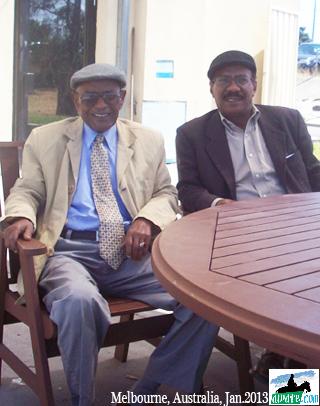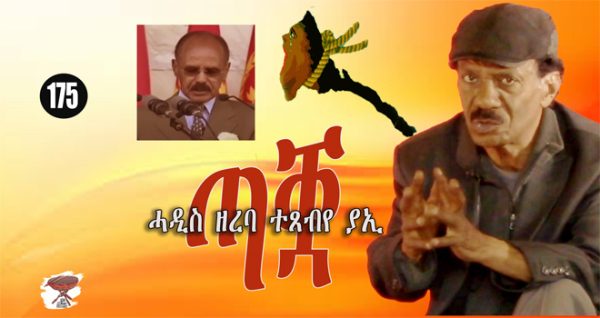Eritrea: A Picture and 1001 Words

Hopefully the person who sent me the above picture in 2001, would come out and be recognized; unfortunately I don’t remember who it was!
I received the picture 14 years ago when awate.com was one-year old, and I believe it first appeared in the Internet accompanying the article below that I wrote on June 2, 2001. Since then, it has become one of the widely circulated iconic images in Eritrean mediums. Awate.com tried to enhance the black and white picture locally with no success; a few days ago I had it professionally enhanced and colorized, but still, I was not content with the finished quality and gave it more touches. Yet, I am not satisfied with the quality though I think it can do for the moment.
If you are superstitious, the fact that the members of the EPLF Politburo in the picture are thirteen is bad luck to begin with. But regardless, it is a sad photo because it reminds us of the fate of the leaders and describes the cruelty of Isaias Afwerki, the 13th person in the picture. As of today, the status of the thirteen Politburo members of the EPLF (1978-1987) is as follows:
Still orbiting around Isaias Afwerki: 1) Ramadan Mohamed Nur, 2) Alamin Mohamed Saeed, and, 3) Sebhat Efrem.
In jail (fate unknown since 2001): 1) Ogbe Abraha, 2) Haile Woldetensae, 3) Petros Solomon, 4) Mahmoud Sheriffo, and, 5) Berhane Gerezgiher.
In Exile: 1) Mesfin Hagos.
Not alive: 1) Ibrahim Aafa (martyred 1985), 2) Ali Sayed Abdella (2005), and 3) Mohamed Saeed Barih, (2008).
Below is the first article as it appeared in 2001, with minor changes, but I kept the by-line as I was using that name before I reclaimed Johar as a permanent name.
One Thousand Words And A Picture
By Saleh Gadi, June 2, 2001
“Time is like a Sword, if you don’t cut, it cuts you.” Arabic proverb
Time always comes uninvited. It always comes with a luggage of sorts. Wrinkles, memory loss, grey hair, and weak senses. But it also comes with maturity. Time is everything, it’s nostalgic; as nostalgic as today’s picture. Did they know what destiny had in store for them? Did they know if they were going to part each other?
The wheel of time rolls. It rolled and rolled. We are in the year 2001. The picture was taken in 1977. Twenty-four years ago. Twenty-four is the age when most Eritreans are either long dead before they reach it, or reached it and are telling stories about death. Twenty-four years of age means an Eritrean has already consumed 50% of his life. A life expectancy of below fifty is the only blessing we have. Thanks to “dagme hntsa,” the reconstruction that made our life expectancy increase dramatically, to forty-something years! Eritreans are destined to die before they become grandparents…in fact many die before they become parents. It’s an Eritrean dilemma: be born, grow up, carry a gun, and go shooting. And before you die, leave someone who will carry the gun to shoot. A shooting offspring, and the cycle goes on. Why should Eritreans live for the gun, and by the gun? Why should we pay non-stop? Isn’t it about time that the rivers of blood dried out? That must change. We need peace. Our situation must change. We need to reform ourselves. We need to eradicate the causes of violence. We need to weed out [i] the cause of violence. We need to change. We need change. We need reform and reformers. Power to the reformers.
Our country is a shining example of endurance. Our people are a proud example of patience. Yet, the whole struggle was for the betterment of the life of the people, but nothing improved. The struggle was to rid them of violence, but violence is abundant. It was to rid them of poverty; they are the poorest of the world. It was to improve healthcare; we are still dying on our forties—if we make it alive through the never-ending cycle of violence. It was to free the Eritrean person; people are languishing in jails. It was to fight injustice; we have perpetuated injustice. What has changed to the common Eritrean? Very little. These are the real issues and not boring statistics of how many clinics were built or how many schools were built. There are globally accepted indexes to measure educational and medical improvements, not crude figures meant for propaganda purposes.
That was the dream; it is not realized yet. Free the people. Let our people explode their subdued energy. Let them embark on an unprecedented development of the self. Take off your hands of issues that are the domain of the people. Help them preserve their freedom; they are the masters of their destiny. No one should be allowed to act like a modern day pharaoh to belittle and humiliate Eritreans. Fairness, justice, shunning violence, and being honest to the tenets of the entire, erstwhile Eritrean dream is what we need. We need change, we should support change. Power to change, power to reform.
The above picture is symbolic. It is symbolic to all Eritreans. It is symbolic to all the organizations that participated in the struggle for liberation of Eritrea. It is symbolic to all who want to contemplate. It is symbolic to our martyrs because one of the people is a Martyr. It is symbolic to those who chose to be silent, because there are some in the picture who are silent. It is symbolic to all reform minded Eritreans, because it has many from the Reform-group. It is symbolic to those who want to maintain the statuesque, because it has those who are the anti-change and anti-reform. It is symbolic. Did you guess who the people in the picture are?
A picture is equal to one thousand words. I have to write one thousand and one words to beat that perception. Few lines to go. Bear with me. I am still at six-hundred ninety-seven words.
The picture was taken in the field. Of course, no one of the group knew what was in store for the Eritrea that they fought for. Yet, they had seeds developing. Seeds of developing characters. One was a leader, he died a leader–the Martyr Ibrahim Afa. Another was a leader; after liberation, he resigned and retired gracefully[ii]–Ramadan Mohammed Nur. Another was a leader, and still is; he wants to remain a leader indefinitely–President Isaias Afwerki. The rest are all still politically active in varying degrees.
Importantly, the picture includes 13 people. If we exclude Ibrahim Aafa, Ramadan Mohammed Nur, and Isaias Afwerki, we remain with ten people. Six of those are among the signatories of the “…Open Letter to All PFDJ Members.” Two are apparently supporting the statuesque and another two do not have a clear stand; in fact Mohammed Said Barih has almost disappeared from the political arena.
Here are the names of 1977-1987 EPLF Politburo members:
Standing, left to right: Ogbe Abraha, Ali Sayed Abdella[iii], Sebhat Efrem, Haile Woldetensae, Petros Solomon, Mohamed Saeed Barih[iv], Mesfin, Hagos, and, Alamin Mohamed Saeed.
Seated, left to right: Berhane Gerezgiher, Ibrahim Aafa (martyred, 1985), Ramadan Mohamed Nur, Isaias Afwerki, and Mahmoud Sheriffo.
A martyr, an exiled veteran, a president, a defence minister, a foreign minister, and the PFDJ Secretary, and another six persons who are equally prominent but chose a different path. Some calibres of people, to quote Ngusse Tesfai, “do not normally have careers. They have destiny.” Power to change; POWER TO REFORM[v].
Endnote:
[i] I held the view of weeding out PFDJ long before the current debate among Eritreans over semantics.
[ii] Addendum: later information indicated he was forced to reign, purged, didn’t exit gracefully.
[iii] Ali Said Abdella was the Foreign Minister of Eritrea when he died in 2005.
[iv] Mohammed Said Barih, died 2008, he was the first foreign minister of Eritrea and governor of Anseba region.
[v] I supported the reform movement but changed my mind convinced it will not work.




Awate Forum